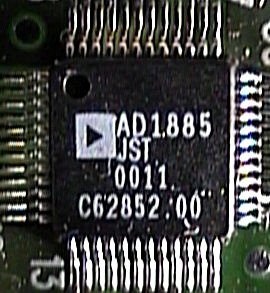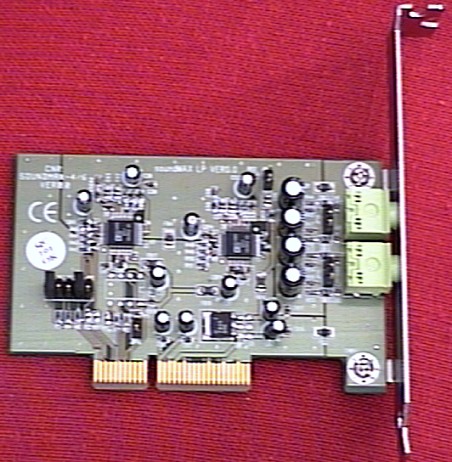
|
A few short years ago, the price of a PC sound card was considered to be a big portion of overall system cost. Until the days of the first ISA sound cards, wavetable MIDI synthesis was considered a high end feature as it required a sound card with dedicated on board memory and a digital signal processor capable of mixing and adding effects (chorus, reverb, mixing, etc.) to MIDI channels and voices.
75% Rating: 
|
|
|
|
Home >
Reviews >
Audio / Sound >
Analog Devices SoundMAX 2.0 |
|
|
Analog Devices SoundMAX 2.0
Review
A few short years ago, the price of a PC
sound card was considered to be a big portion of overall system cost. Until the
days of the first ISA sound cards, wavetable MIDI synthesis was considered a
high end feature as it required a sound card with dedicated on board memory and
a digital signal processor capable of mixing and adding effects (chorus, reverb,
mixing, etc.) to MIDI channels and voices.
The first major breakthrough to
having realistic audio on the PC was the release of the Sound Blaster sound card
which was based upon the aged ISA architecture. With the subsequent introduction
of the PCI expansion bus, sound card manufacturers began to realize the
advantages of PCI over ISA (such as a wider and faster data bus) and thus began
to release a slew of PCI based sound cards.
Some PCI based sound cards
even made use of system memory and sometimes the host CPU for wavetable MIDI
synthesis.
 AC97: a good idea suffering from bad implementation? AC97: a good idea suffering from bad implementation?
While the PCI bus
had the necessary bandwidth for handling multiple wave channels, sound cards
continued to have considerably higher costs. After the development of higher
clocked processors, Intel introduced the AC97 standard in 1996. The AC97 CODEC
was the first move in developing lower cost sound solutions with more than
adequate sound quality. Since the most expensive parts of a sound card are the
DSP (Digital Signal Processor) and the ADC/DACs (Analog to Digital
Converter/Digital to Analog Converter), elimination of either was necessary in
order to build a cost effective solution. In the end, it was the DSP to be axed
as its various functions could be processed by the host CPU through specially
written drivers.
Since then, most motherboard chipsets have AC97 support
which can be paired with a AC97 CODEC (COder/DECoder). The AC97 CODEC features
at least a 2 channel ADC (Analog to Digital Converter), a 2 channel DAC (Digital
to Analog Converter), a mixer and a I/O controller. The basic idea behind AC97
integration is exactly the same as with software modems where part of the
workload of the modem is done by the host processor. All modern PCI sound cards
have AC97 CODEC's and a DSP while most motherboards with integrated audio make
use of only the AC97 standard.
While the introduction of the AC97
standard was the right move for the industry (decent sound reproduction at low
cost), there are a few problems. First of all, since the AC97 is considered to
be a low cost alternative, many motherboard manufacturers provide AC97 ready
motherboards with poor sound quality. This was the result of bad design,
improper shielding and a lack of effort to provide a decent sound
solution.
Though our words may seem harsh, the cold reality is that in
practice, very few boards even offer sound quality comparable to lower cost
sound cards. In addition, most AC97 manufacturers have been providing solutions
with limited features (lack of bass/treble adjustments, lack of S/PDIF In/Out,
no support for DirectSound3D APIs, etc.).
Basics of Analog Devices
SoundMAX 2.0
Analog Devices have a long history in making digital components
for PC sound cards and other sound devices. They have introduced the SoundMAX
AC97 CODEC, which according to specifications offers a good number of features
comparable to mainstream PCI sound cards. While their solution is still a
standalone AC97, its performance and feature set place it among mainstream PCI
soundcards.
Intel provided us with the D810E2CA3 (Cayman 3) motherboard,
which features a AD1885 AC97 CODEC (2 channel output) and a CNR riser card
featuring two AD1885 CODECs (4 channel output).
Up to three AD1885 CODECs can be
combined to produce 6 channel output.
 |
| A shot a CNR based SoundMAX
2.0 card |
|

